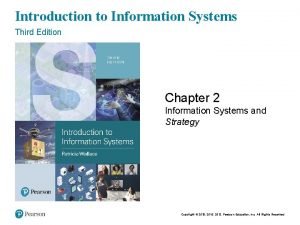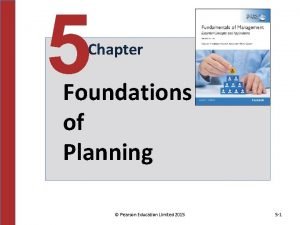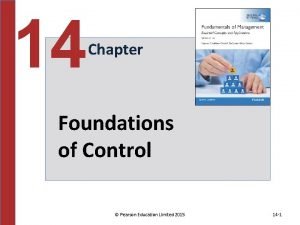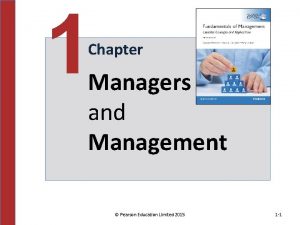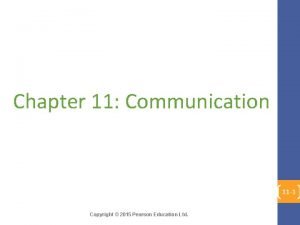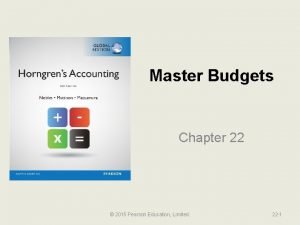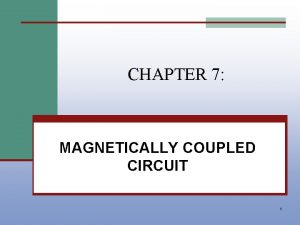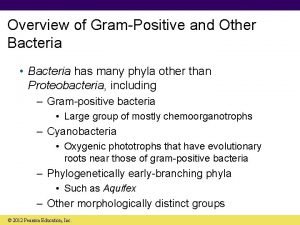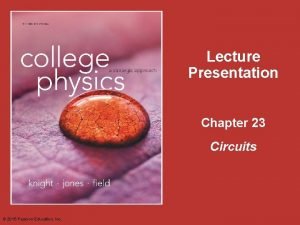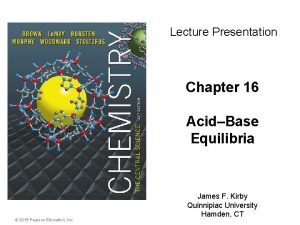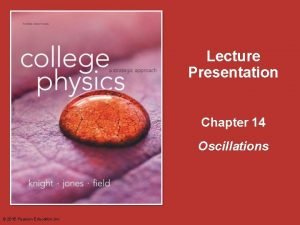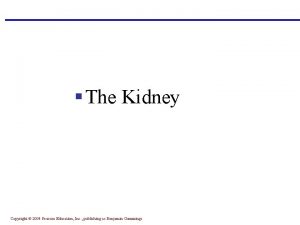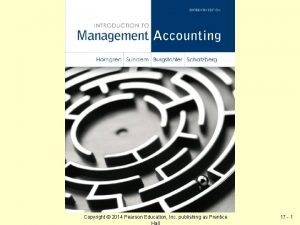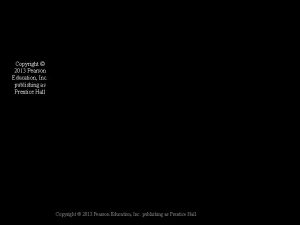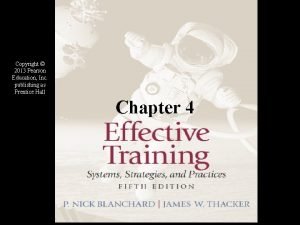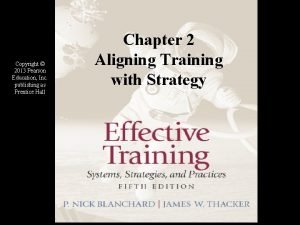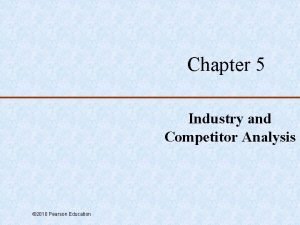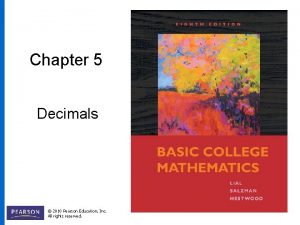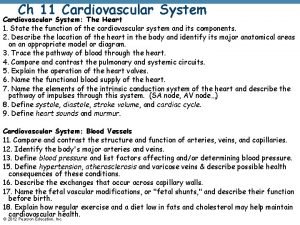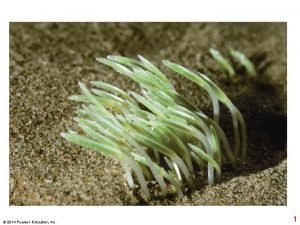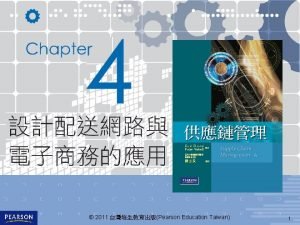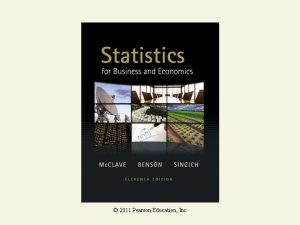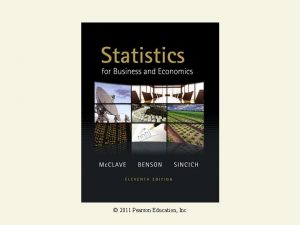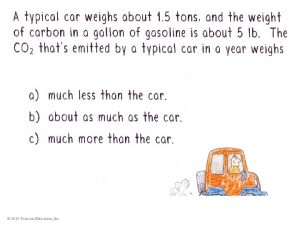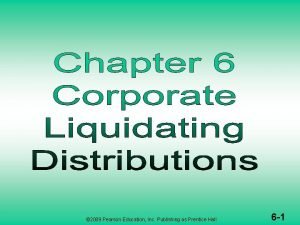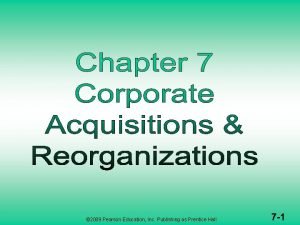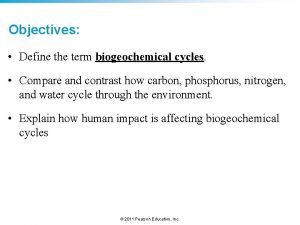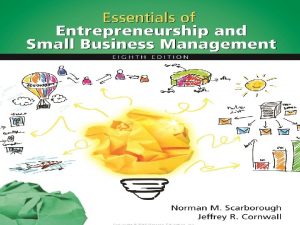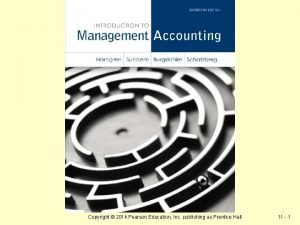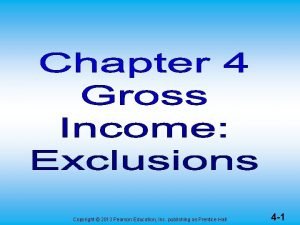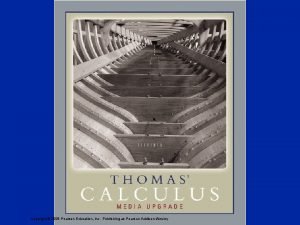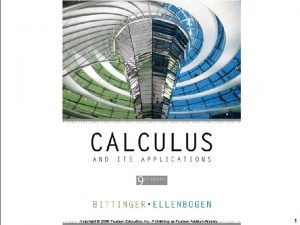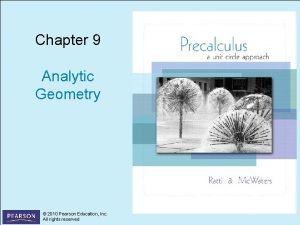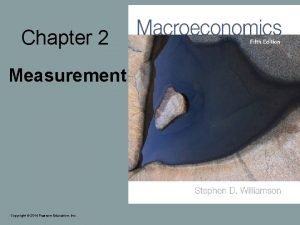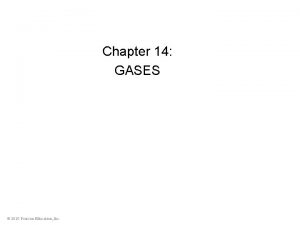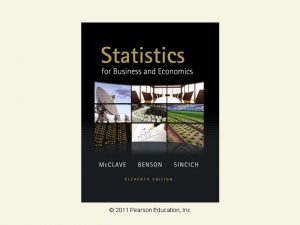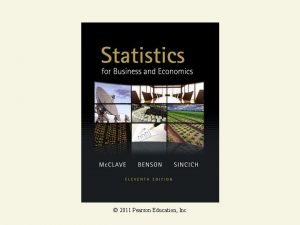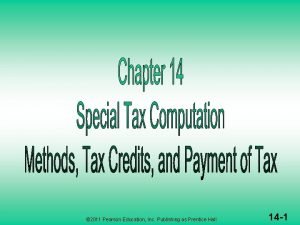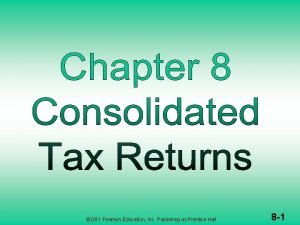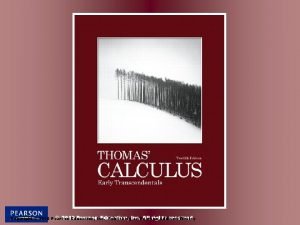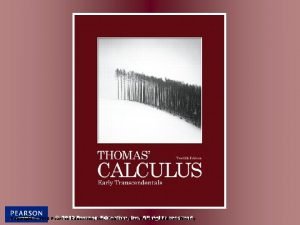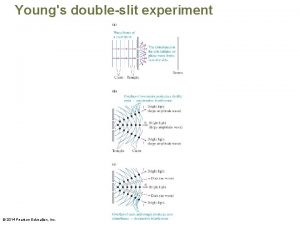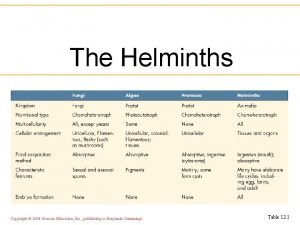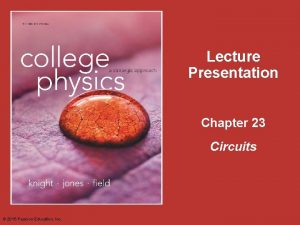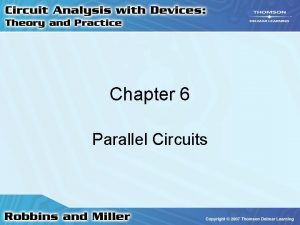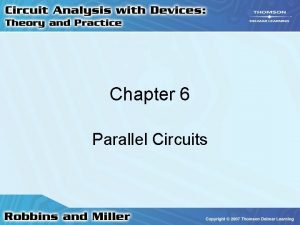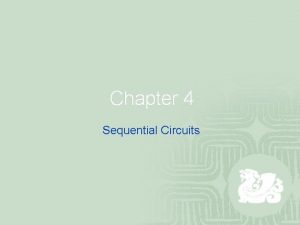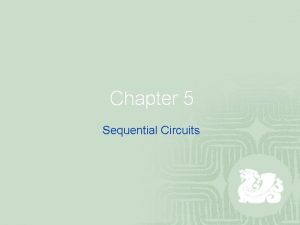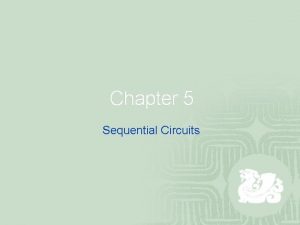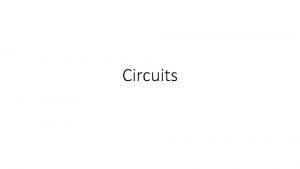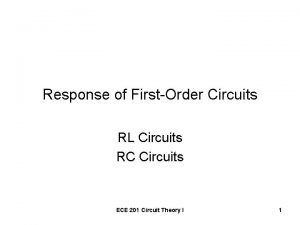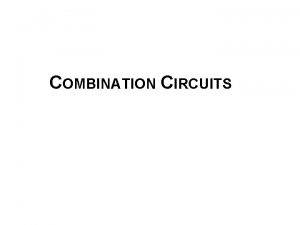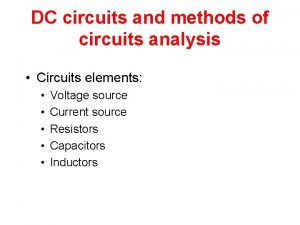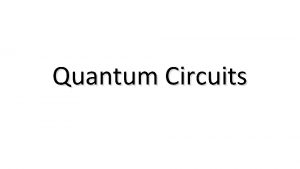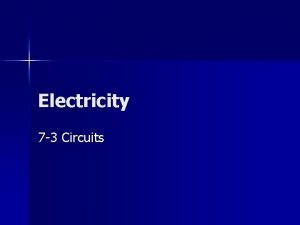Lecture Presentation Chapter 23 Circuits 2015 Pearson Education


























































































































- Slides: 122

Lecture Presentation Chapter 23 Circuits © 2015 Pearson Education, Inc.

Section 23. 2 Kirchhoff’s Law © 2015 Pearson Education, Inc.

Kirchhoff’s Laws • Kirchhoff’s junction law, as we learned in Chapter 22, states that the total current into a junction must equal the total current leaving the junction. • This is a result of charge and current conservation: © 2015 Pearson Education, Inc. Slide 23 -3

Kirchhoff’s Laws • The gravitational potential energy of an object depends only on its position, not on the path it took to get to that position. • The same is true of electric potential energy. If a charged particle moves around a closed loop and returns to its starting point, there is no net change in its electric potential energy: Δuelec = 0. • Because V = Uelec/q, the net change in the electric potential around any loop or closed path must be zero as well. © 2015 Pearson Education, Inc. Slide 23 -4

Kirchhoff’s Laws © 2015 Pearson Education, Inc. Slide 23 -5

Kirchhoff’s Laws • For any circuit, if we add all of the potential differences around the loop formed by the circuit, the sum must be zero. • This result is Kirchhoff’s loop law: • ΔVi is the potential difference of the ith component of the loop. © 2015 Pearson Education, Inc. Slide 23 -6

Kirchhoff’s Laws Text: p. 730 © 2015 Pearson Education, Inc. Slide 23 -7

Kirchhoff’s Laws • ΔVbat can be positive or negative for a battery, but ΔVR for a resistor is always negative because the potential in a resistor decreases along the direction of the current. • Because the potential across a resistor always decreases, we often speak of the voltage drop across the resistor. © 2015 Pearson Education, Inc. Slide 23 -8

Kirchhoff’s Laws • The first three steps of the analysis of the basic circuit using Kirchhoff’s Laws: © 2015 Pearson Education, Inc. Slide 23 -9

Kirchhoff’s Laws • The fourth step in analyzing a circuit is to apply Kirchhoff’s loop law: • First we must find the values for ΔVbat and ΔVR. © 2015 Pearson Education, Inc. Slide 23 -10

Kirchhoff’s Laws • The potential increases as we travel through the battery on our clockwise journey around the loop. We enter the negative terminal and exit the positive terminal after having gained potential ℇ. • Thus ΔVbat = + ℇ. © 2015 Pearson Education, Inc. Slide 23 -11

Kirchhoff’s Laws • The magnitude of the potential difference across the resistor is ΔV = IR, but Ohm’s law does not tell us whether this should be positive or negative. The potential of a resistor decreases in the direction of the current, which is indicated with + and signs in the figure. • Thus, ΔVR = IR. © 2015 Pearson Education, Inc. Slide 23 -12

Kirchhoff’s Laws • With the values of ΔVbat and ΔVR, we can use Kirchhoff’s loop law: • We can solve for the current in the circuit: © 2015 Pearson Education, Inc. Slide 23 -13

Quick. Check 23. 6 The diagram below shows a segment of a circuit. What is the current in the 200 Ω resistor? A. B. C. D. E. 0. 5 A 1. 0 A 1. 5 A 2. 0 A There is not enough information to decide. © 2015 Pearson Education, Inc. Slide 23 -14

Quick. Check 23. 6 The diagram below shows a segment of a circuit. What is the current in the 200 Ω resistor? A. B. C. D. E. 0. 5 A 1. 0 A 1. 5 A 2. 0 A There is not enough information to decide. © 2015 Pearson Education, Inc. Slide 23 -15

Example Problem There is a current of 1. 0 A in the following circuit. What is the resistance of the unknown circuit element? © 2015 Pearson Education, Inc. Slide 23 -16

Section 23. 3 Series and Parallel Circuits © 2015 Pearson Education, Inc.

Series and Parallel Circuits • There are two possible ways that you can connect the circuit. • Series and parallel circuits have very different properties. • We say two bulbs are connected in series if they are connected directly to each other with no junction in between. © 2015 Pearson Education, Inc. Slide 23 -18

Quick. Check 23. 5 Which is the correct circuit diagram for the circuit shown? © 2015 Pearson Education, Inc. Slide 23 -19

Quick. Check 23. 5 Which is the correct circuit diagram for the circuit shown? A © 2015 Pearson Education, Inc. Slide 23 -20

Example 23. 2 Brightness of bulbs in series FIGURE 23. 11 shows two identical lightbulbs connected in series. Which bulb is brighter: A or B? Or are they equally bright? © 2015 Pearson Education, Inc. Slide 23 -21

Example 23. 2 Brightness of bulbs in series (cont. ) Current is conserved, and there are no junctions in the circuit. Thus, as FIGURE 23. 12 shows, the current is the same at all points. REASON © 2015 Pearson Education, Inc. Slide 23 -22

Quick. Check 23. 12 Which bulb is brighter? A. B. C. D. The 60 W bulb. The 100 W bulb. Their brightnesses are the same. There’s not enough information to tell. © 2015 Pearson Education, Inc. Slide 23 -23

Quick. Check 23. 12 Which bulb is brighter? A. B. C. D. The 60 W bulb. The 100 W bulb. Their brightnesses are the same. There’s not enough information to tell. P = I 2 R and both have the same current. © 2015 Pearson Education, Inc. Slide 23 -24

Series Resistors • This figure shows two resistors in series connected to a battery. • Because there are no junctions, the current I must be the same in both resistors. © 2015 Pearson Education, Inc. Slide 23 -25

Series Resistors • We use Kirchhoff’s loop law to look at the potential differences. © 2015 Pearson Education, Inc. Slide 23 -26

Quick. Check 23. 13 The battery current I is A. B. C. D. E. 3 A 2 A 1 A 2/3 A 1/2 A © 2015 Pearson Education, Inc. Slide 23 -27

Quick. Check 23. 13 The battery current I is A. B. C. D. E. 3 A 2 A 1 A 2/3 A 1/2 A © 2015 Pearson Education, Inc. Slide 23 -28

Quick. Check 23. 9 The diagram below shows a circuit with two batteries and three resistors. What is the potential difference across the 200 Ω resistor? A. B. C. D. E. 2. 0 V 3. 0 V 4. 5 V 7. 5 V There is not enough information to decide. © 2015 Pearson Education, Inc. Slide 23 -29

Quick. Check 23. 9 The diagram below shows a circuit with two batteries and three resistors. What is the potential difference across the 200 Ω resistor? A. B. C. D. E. 2. 0 V 3. 0 V 4. 5 V 7. 5 V There is not enough information to decide. © 2015 Pearson Education, Inc. Slide 23 -30

Series Resistors • If we replace two resistors with a single resistor having the value Req = R 1 + R 2 the total potential difference across this resistor is still ℇ because the potential difference is established by the battery. © 2015 Pearson Education, Inc. Slide 23 -31

Series Resistors • The current in the single resistor circuit is: • The single resistor is equivalent to the two series resistors in the sense that the circuit’s current and potential difference are the same in both cases. • If we have N resistors in series, their equivalent resistance is the sum of the N individual resistances: © 2015 Pearson Education, Inc. Slide 23 -32

Quick. Check 23. 7 The current through the 3 resistor is A. B. C. D. E. 9 A 6 A 5 A 3 A 1 A © 2015 Pearson Education, Inc. Slide 23 -33

Quick. Check 23. 7 The current through the 3 resistor is A. B. C. D. E. 9 A 6 A 5 A 3 A 1 A © 2015 Pearson Education, Inc. Slide 23 -34

Series Resistors • We compare two circuits: one with a single lightbulb, and the other with two lightbulbs connected in series. All of the batteries and bulbs are identical. • How does the brightness of the bulbs in the different circuits compare? © 2015 Pearson Education, Inc. Slide 23 -35

Series Resistors • In a circuit with one bulb, circuit A, a battery drives the current IA = ℇ/R through the bulb. • In a circuit, with two bulbs (in series) with the same resistance R, circuit B, the equivalent resistance is Req = 2 R. • The current running through the bulbs in the circuit B is IB = ℇ/2 R. • Since the emf from the battery and the resistors are the same in each circuit, IB = ½ IA. • The two bulbs in circuit B are equally bright, but they are dimmer than the bulb in circuit A because there is less current. © 2015 Pearson Education, Inc. Slide 23 -36

Series Resistors • A battery is a source of potential difference, not a source of current. • The battery does provide the current in a circuit, but the amount of current depends on the resistance. • The amount of current depends jointly on the battery’s emf and the resistance of the circuit attached to the battery. © 2015 Pearson Education, Inc. Slide 23 -37

Parallel Resistors • In a circuit where two bulbs are connected at both ends, we say that they are connected in parallel. © 2015 Pearson Education, Inc. Slide 23 -38

Conceptual Example 23. 5 Brightness of bulbs in parallel Which lightbulb in the circuit of FIGURE 23. 18 is brighter: A or B? Or are they equally bright? © 2015 Pearson Education, Inc. Slide 23 -39

Conceptual Example 23. 5 Brightness of bulbs in parallel (cont. ) Because the bulbs are identical, the currents through the two bulbs are equal and thus the bulbs are equally bright. © 2015 Pearson Education, Inc. Slide 23 -40

Conceptual Example 23. 5 Brightness of bulbs in parallel (cont. ) One might think that A would be brighter than B because current takes the “shortest route. ” But current is determined by potential difference, and two bulbs connected in parallel have the same potential difference. ASSESS © 2015 Pearson Education, Inc. Slide 23 -41

Parallel Resistors • The potential difference across each resistor in parallel is equal to the emf of the battery because both resistors are connected directly to the battery. © 2015 Pearson Education, Inc. Slide 23 -42

Parallel Resistors • The current Ibat from the battery splits into currents I 1 and I 2 at the top of the junction. • According to the junction law, • Applying Ohm’s law to each resistor, we find that the battery current is © 2015 Pearson Education, Inc. Slide 23 -43

Parallel Resistors • Can we replace a group of parallel resistors with a single equivalent resistor? • To be equivalent, ΔV must equal ℇ and I must equal Ibat: • This is the equivalent resistance, so a single Req acts exactly the same as multiple resistors. © 2015 Pearson Education, Inc. Slide 23 -44

Parallel Resistors © 2015 Pearson Education, Inc. Slide 23 -45

Parallel Resistors • How does the brightness of bulb B compare to that of bulb A? • Each bulb is connected to the same potential difference, that of the battery, so they all have the same brightness. • In the second circuit, the battery must power two lightbulbs, so it provides twice as much current. © 2015 Pearson Education, Inc. Slide 23 -46

Quick. Check 23. 11 Which resistor dissipates more power? A. The 9 resistor B. The 1 resistor C. They dissipate the same power © 2015 Pearson Education, Inc. Slide 23 -47

Quick. Check 23. 11 Which resistor dissipates more power? A. The 9 resistor B. The 1 resistor C. They dissipate the same power © 2015 Pearson Education, Inc. Slide 23 -48

Example 23. 6 Current in a parallel resistor circuit The three resistors of FIGURE 23. 22 are connected to a 12 V battery. What current is provided by the battery? [Insert Figure 23. 22] © 2015 Pearson Education, Inc. Slide 23 -49

Example 23. 6 Current in a parallel resistor circuit (cont. ) We can use Equation 23. 12 to calculate the equivalent resistance: SOLVE Once we know the equivalent resistance, we can use Ohm’s law to calculate the current leaving the battery: © 2015 Pearson Education, Inc. Slide 23 -50

Example 23. 6 Current in a parallel resistor circuit (cont. ) Because the battery can’t tell the difference between the original three resistors and this single equivalent resistor, the battery in Figure 23. 22 provides a current of 0. 66 A to the circuit. As we’ll see, the equivalent resistance of a group of parallel resistors is less than the resistance of any of the resistors in the group. 18 Ω is less than any of the individual values, a good check on our work. ASSESS © 2015 Pearson Education, Inc. Slide 23 -51

Parallel Resistors • It would seem that more resistors would imply more resistance. This is true for resistors in series, but not for resistors in parallel. • Parallel resistors provide more pathways for charge to get through. • The equivalent of several resistors in parallel is always less than any single resistor in the group. • An analogy is driving in heavy traffic. If there is an alternate route for cars to travel, more cars will be able to flow. © 2015 Pearson Education, Inc. Slide 23 -52

Quick. Check 23. 15 When the switch closes, the battery current A. Increases. B. Stays the same. C. Decreases. © 2015 Pearson Education, Inc. Slide 23 -53

Quick. Check 23. 15 When the switch closes, the battery current A. Increases. B. Stays the same. C. Decreases. Equivalent resistance decreases. Potential difference is unchanged. © 2015 Pearson Education, Inc. Slide 23 -54

Quick. Check 23. 2 The three bulbs are identical and the two batteries are identical. Compare the brightnesses of the bulbs. A. B. C. D. E. A B C A C B A B C © 2015 Pearson Education, Inc. Slide 23 -55

Quick. Check 23. 2 The three bulbs are identical and the two batteries are identical. Compare the brightnesses of the bulbs. A. B. C. D. E. A B C A C B A B C This question is checking your initial intuition. We’ll return to it later. © 2015 Pearson Education, Inc. Slide 23 -56

Quick. Check 23. 3 The three bulbs are identical and the two batteries are identical. Compare the brightnesses of the bulbs. A. B. C. D. E. A B C A C B A B C © 2015 Pearson Education, Inc. Slide 23 -57

Quick. Check 23. 3 The three bulbs are identical and the two batteries are identical. Compare the brightnesses of the bulbs. A. B. C. D. E. A B C A C B A B C This question is checking your initial intuition. We’ll return to it later. © 2015 Pearson Education, Inc. Slide 23 -58

Quick. Check 23. 18 The lightbulbs are identical. Initially both bulbs are glowing. What happens when the switch is closed? A. Nothing. B. A stays the same; B gets dimmer. C. A gets brighter; B stays the same. D. Both get dimmer. E. A gets brighter; B goes out. © 2015 Pearson Education, Inc. Slide 23 -59

Quick. Check 23. 18 The lightbulbs are identical. Initially both bulbs are glowing. What happens when the switch is closed? A. Nothing. B. A stays the same; B gets dimmer. C. A gets brighter; B stays the same. D. Both get dimmer. E. A gets brighter; B goes out. © 2015 Pearson Education, Inc. Short circuit. Zero resistance path. Slide 23 -60

Section 23. 5 More Complex Circuits © 2015 Pearson Education, Inc.

Example 23. 8 How does the brightness change? Initially the switch in FIGURE 23. 28 is open. Bulbs A and B are equally bright, and bulb C is not glowing. What happens to the brightness of A and B when the switch is closed? And how does the brightness of C then compare to that of A and B? Assume that all bulbs are identical. © 2015 Pearson Education, Inc. Slide 23 -62

Example 23. 8 How does the brightness change? (cont. ) SOLVE This is the initial current in bulbs A and B, so they are equally bright. © 2015 Pearson Education, Inc. Slide 23 -63

Example 23. 8 How does the brightness change? (cont. ) Closing the switch places bulbs B and C in parallel with each other. © 2015 Pearson Education, Inc. Slide 23 -64

Example 23. 8 How does the brightness change? (cont. ) All the current from the battery passes through bulb A, so A increases in brightness when the switch is closed. • The current Iafter then splits at the junction • *Bulbs B and C have equal resistance, so the current divides equally. • The current in B is (ℇ/R), which is less than Ibefore. Thus B decreases in brightness • B= C © 2015 Pearson Education, Inc. Slide 23 -65

Example Problem What is the current supplied by the battery in the following circuit? What is the current through each resistor in the circuit? What is the potential difference across each resistor? © 2015 Pearson Education, Inc. Slide 23 -66

Example Problem What is the equivalent resistance of the following circuit? © 2015 Pearson Education, Inc. Slide 23 -67

Section 23. 6 Capacitors in Parallel and Series © 2015 Pearson Education, Inc.

Capacitors in Parallel and Series • A capacitor is a circuit element made of two conductors separated by an insulating layer. • When the capacitor is connected to the battery, charge will flow to the capacitor, increasing its potential difference until ΔVC = ℇ • Once the capacitor is fully charged, there will be no further current. © 2015 Pearson Education, Inc. Slide 23 -69

Capacitors in Parallel and Series • Parallel or series capacitors can be represented by a single equivalent capacitance. © 2015 Pearson Education, Inc. Slide 23 -70

Capacitors in Parallel and Series • The total charge Q on the two capacitors is © 2015 Pearson Education, Inc. Slide 23 -71

Capacitors in Parallel and Series • We can replace two capacitors in parallel by a single equivalent capacitance Ceq: • The equivalent capacitance has the same ΔVC but a greater charge. © 2015 Pearson Education, Inc. Slide 23 -72

Capacitors in Parallel and Series • If N capacitors are in parallel, their equivalent capacitance is the sum of the individual capacitances: © 2015 Pearson Education, Inc. Slide 23 -73

Capacitors in Parallel and Series © 2015 Pearson Education, Inc. Slide 23 -74

Capacitors in Parallel and Series • The potential differences across two capacitors in series are ΔV 1 = Q/C 1 and ΔV 2 = Q/C 2 • The total potential difference across both capacitors is ΔVC = ΔV 1 + ΔV 2 © 2015 Pearson Education, Inc. Slide 23 -75

Capacitors in Parallel and Series • If we replace the two capacitors with a single capacitor having charge Q and potential difference ΔVC, then the inverse of the capacitance of this equivalent capacitor is • This analysis hinges on the fact that series capacitors each have the same charge Q. © 2015 Pearson Education, Inc. Slide 23 -76

Capacitors in Parallel and Series • If N capacitors are in series, their equivalent capacitance is the inverse of the sum of the inverses of the individual capacitances: • For series capacitors the equivalent capacitance is less than that of the individual capacitors. © 2015 Pearson Education, Inc. Slide 23 -77

Quick. Check 23. 21 Which of the following combinations of capacitors has the highest capacitance? © 2015 Pearson Education, Inc. Slide 23 -78

Quick. Check 23. 21 Which of the following combinations of capacitors has the highest capacitance? B © 2015 Pearson Education, Inc. Slide 23 -79

Quick. Check 23. 22 Which capacitor discharges more quickly after the switch is closed? A. Capacitor A B. Capacitor B C. They discharge at the same rate. D. We can’t say without knowing the initial amount of charge. © 2015 Pearson Education, Inc. Slide 23 -80

Quick. Check 23. 22 Which capacitor discharges more quickly after the switch is Smaller time constant = RC closed? A. Capacitor A B. Capacitor B C. They discharge at the same rate. D. We can’t say without knowing the initial amount of charge. © 2015 Pearson Education, Inc. Slide 23 -81

Example 23. 10 Analyzing a capacitor circuit a. Find the equivalent capacitance of the combination of capacitors in the circuit of FIGURE 23. 35. b. What charge flows through the battery as the capacitors are being charged? © 2015 Pearson Education, Inc. Slide 23 -82

Example 23. 10 Analyzing a capacitor circuit (cont. ) We can use the relationships for parallel and series capacitors to reduce the capacitors to a single equivalent capacitance, much as we did for resistor circuits. We can then compute the charge through the battery using this value of capacitance. PREPARE © 2015 Pearson Education, Inc. Slide 23 -83

Example 23. 10 Analyzing a capacitor circuit (cont. ) © 2015 Pearson Education, Inc. Slide 23 -84

Example 23. 10 Analyzing a capacitor circuit (cont. ) © 2015 Pearson Education, Inc. Slide 23 -85

Example 23. 10 Analyzing a capacitor circuit (cont. ) The battery sees a capacitance of 2. 0 F. To establish a potential difference of 12 V, the charge that must flow is Q = Ceq ∆VC = (2. 0 10− 6 F)(12 V) = 2. 4 10− 5 C We solve capacitor circuit problems in a manner very similar to what we followed for resistor circuits. ASSESS © 2015 Pearson Education, Inc. Slide 23 -86

Section 23. 7 RC Circuits © 2015 Pearson Education, Inc.

RC Circuits • RC circuits are circuits containing resistors and capacitors. • In RC circuits, the current varies with time. • The values of the resistance and the capacitance in an RC circuit determine the time it takes the capacitor to charge or discharge. © 2015 Pearson Education, Inc. Slide 23 -88

RC Circuits • The figure shows an RC circuit consisting of a charged capacitor, an open switch, and a resistor before the switch closes. The switch will close at t = 0. © 2015 Pearson Education, Inc. Slide 23 -89

RC Circuits © 2015 Pearson Education, Inc. Slide 23 -90

RC Circuits • The initial potential difference is (ΔVC)0 = Q 0/C. • The initial current—the initial rate at which the capacitor begins to discharge—is © 2015 Pearson Education, Inc. Slide 23 -91

RC Circuits © 2015 Pearson Education, Inc. Slide 23 -92

RC Circuits • After some time, both the charge on the capacitor (and thus the potential difference) and the current in the circuit have decreased. • When the capacitor voltage has decreased to ΔVC, the current has decreased to • The current and the voltage decrease until the capacitor is fully discharged and the current is zero. © 2015 Pearson Education, Inc. Slide 23 -93

RC Circuits • The current and the capacitor voltage decay to zero after the switch closes, but not linearly. © 2015 Pearson Education, Inc. Slide 23 -94

RC Circuits • The decays of the voltage and the current are exponential decays: © 2015 Pearson Education, Inc. Slide 23 -95

RC Circuits • The time constant is a characteristic time for a circuit. A long time constant implies a slow decay; a short time constant, a rapid decay: = RC • In terms of the time constant, the current and voltage equations are © 2015 Pearson Education, Inc. Slide 23 -96

RC Circuits • The current and voltage in a circuit do not drop to zero after one time constant. Each increase in time by one time constant causes the voltage and current to decrease by a factor of e− 1 = 0. 37. © 2015 Pearson Education, Inc. Slide 23 -97

RC Circuits © 2015 Pearson Education, Inc. Slide 23 -98

RC Circuits • The time constant has the form = RC. • A large resistance opposes the flow of charge, so increasing R increases the decay time. • A larger capacitance stores more charge, so increasing C also increases the decay time. © 2015 Pearson Education, Inc. Slide 23 -99

Quick. Check 23. 23 The following circuits contain capacitors that are charged to 5. 0 V. All of the switches are closed at the same time. After 1 second has passed, which capacitor is charged to the highest voltage? © 2015 Pearson Education, Inc. Slide 23 -100

Quick. Check 23. 23 The following circuits contain capacitors that are charged to 5. 0 V. All of the switches are closed at the same time. After 1 second has passed, which capacitor is charged to the highest voltage? C © 2015 Pearson Education, Inc. Slide 23 -101

Quick. Check 23. 24 In the following circuit, the switch is initially closed and the bulb glows brightly. When the switch is opened, what happens to the brightness of the bulb? A. The brightness of the bulb is not affected. B. The bulb starts at the same brightness and then gradually dims. C. The bulb starts and the same brightness and then gradually brightens. D. The bulb initially brightens, then gradually dims. E. The bulb initially dims, then gradually brightens. © 2015 Pearson Education, Inc. Slide 23 -102

Quick. Check 23. 24 In the following circuit, the switch is initially closed and the bulb glows brightly. When the switch is opened, what happens to the brightness of the bulb? A. The brightness of the bulb is not affected. B. The bulb starts at the same brightness and then gradually dims. C. The bulb starts and the same brightness and then gradually brightens. D. The bulb initially brightens, then gradually dims. E. The bulb initially dims, then gradually brightens. © 2015 Pearson Education, Inc. Slide 23 -103

Example 23. 11 Finding the current in an RC circuit The switch in the circuit of FIGURE 23. 40 has been in position a for a long time, so the capacitor is fully charged. The switch is changed to position b at t = 0. What is the current in the circuit immediately after the switch is closed? What is the current in the circuit 25 μs later? © 2015 Pearson Education, Inc. Slide 23 -104

Example 23. 11 Finding the current in an RC circuit (cont. ) The capacitor is connected across the battery terminals, so initially it is charged to (∆VC)0 = 9. 0 V. When the switch is closed, the initial current is given by Equation 23. 20: SOLVE © 2015 Pearson Education, Inc. Slide 23 -105

Example 23. 11 Finding the current in an RC circuit (cont. ) As charge flows, the capacitor discharges. The time constant for the decay is given by Equation 23. 23: © 2015 Pearson Education, Inc. Slide 23 -106

Example 23. 11 Finding the current in an RC circuit (cont. ) The current in the circuit as a function of time is given by Equation 23. 22. 25 s after the switch is closed, the current is © 2015 Pearson Education, Inc. Slide 23 -107

Charging a Capacitor • In a circuit that charges a capacitor, once the switch is closed, the potential difference of the battery causes a current in the circuit, and the capacitor begins to charge. • As the capacitor charges, it develops a potential difference that opposes the current, so the current decreases, and so does the rate of charging. • The capacitor charges until ΔVC = ℇ. © 2015 Pearson Education, Inc. Slide 23 -108

Charging a Capacitor • The equations that describe the capacitor voltage and the current as a function of time are © 2015 Pearson Education, Inc. Slide 23 -109

Quick. Check 23. 25 The capacitor is initially unchanged. Immediately after the switch closes, the capacitor voltage is A. 0 V B. Somewhere between 0 V and 6 V C. 6 V D. Undefined. © 2015 Pearson Education, Inc. Slide 23 -110

Quick. Check 23. 25 The capacitor is initially unchanged. Immediately after the switch closes, the capacitor voltage is A. 0 V B. Somewhere between 0 V and 6 V C. 6 V D. Undefined. © 2015 Pearson Education, Inc. Slide 23 -111

Quick. Check 23. 26 The red curve shows how the capacitor charges after the switch is closed at t = 0. Which curve shows the capacitor charging if the value of the resistor is reduced? B © 2015 Pearson Education, Inc. Slide 23 -112

Quick. Check 23. 26 The red curve shows how the capacitor charges after the switch is closed at t = 0. Which curve shows the capacitor charging if the value of the resistor is reduced? B Smaller time constant. Same ultimate amount of charge. © 2015 Pearson Education, Inc. Slide 23 -113

Example Problem The switch in the circuit shown has been in position a for a long time, so the capacitor is fully charged. The switch is changed to position b at t = 0. What is the current in the circuit immediately after the switch is closed? What is the current in the circuit 25 s later? The initial current is Delta_V_C/R = 9 V/10 Ohms = 0. 9 Amps. The time constant for the circuit is RC = 1 E-5 seconds, so at t = 25 E-6 seconds the current is 0. 9*exp(-2. 5) = 0. 07 Amps. Slide 23 -114

Summary: General Principles Text: p. 753 © 2015 Pearson Education, Inc. Slide 23 -115

Summary: General Principles Text: p. 753 © 2015 Pearson Education, Inc. Slide 23 -116

Summary: Important Concepts Text: p. 753 © 2015 Pearson Education, Inc. Slide 23 -117

Summary: Important Concepts Text: p. 753 © 2015 Pearson Education, Inc. Slide 23 -118

Summary: Applications Text: p. 753 © 2015 Pearson Education, Inc. Slide 23 -119

Summary Text: p. 753 © 2015 Pearson Education, Inc. Slide 23 -120

Summary Text: p. 753 © 2015 Pearson Education, Inc. Slide 23 -121

Summary Text: p. 753 © 2015 Pearson Education, Inc. Slide 23 -122
 2015 pearson education inc
2015 pearson education inc 2015 pearson education inc
2015 pearson education inc Pearson education limited 2015
Pearson education limited 2015 Foundations of planning
Foundations of planning 2015 pearson education inc
2015 pearson education inc 2015 pearson education inc
2015 pearson education inc Pearson education limited 2015
Pearson education limited 2015 Pearson education limited 2015
Pearson education limited 2015 Pearson education limited 2015
Pearson education limited 2015 Pearson education limited 2015
Pearson education limited 2015 2015 pearson education inc
2015 pearson education inc Pearson education limited 2015
Pearson education limited 2015 2015 pearson education inc
2015 pearson education inc 2015 pearson education inc
2015 pearson education inc 2015 pearson education inc
2015 pearson education inc Pearson education limited 2015
Pearson education limited 2015 Pearson education limited 2015
Pearson education limited 2015 Pearson education inc publishing
Pearson education inc publishing 2015 pearson education inc
2015 pearson education inc Prentice hall publishing
Prentice hall publishing 2011 pearson education inc
2011 pearson education inc Pearson education inc publishing as pearson prentice hall
Pearson education inc publishing as pearson prentice hall Pearson education inc. 2012
Pearson education inc. 2012 2008 pearson prentice hall inc
2008 pearson prentice hall inc Advantages of parallel circuits over series circuits
Advantages of parallel circuits over series circuits Magnetically coupled circuits lecture notes
Magnetically coupled circuits lecture notes 01:640:244 lecture notes - lecture 15: plat, idah, farad
01:640:244 lecture notes - lecture 15: plat, idah, farad Pearson 2015
Pearson 2015 Pearson 2015
Pearson 2015 Pearson 2015
Pearson 2015 Pearson 2015
Pearson 2015 Pearson vue robert whelan
Pearson vue robert whelan Educational pearson pearson times
Educational pearson pearson times Iso 9001:2015 awareness training ppt
Iso 9001:2015 awareness training ppt Iso 9001 presentation
Iso 9001 presentation Lecture presentation software
Lecture presentation software Malaysia education blueprint 2015 to 2025
Malaysia education blueprint 2015 to 2025 Education for all 2000-2015: achievements and challenges
Education for all 2000-2015: achievements and challenges Education at a glance 2015
Education at a glance 2015 Water cycle pearson education
Water cycle pearson education Pearson education, inc
Pearson education, inc Pearson education limited 2008
Pearson education limited 2008 Nitrogen cycle pearson education
Nitrogen cycle pearson education Pearson education limited 2005
Pearson education limited 2005 2018 pearson education inc
2018 pearson education inc Pearson education ltd 2017
Pearson education ltd 2017 Copyright pearson education inc
Copyright pearson education inc Copyright pearson education inc
Copyright pearson education inc 2017 pearson education inc
2017 pearson education inc 2017 pearson education inc
2017 pearson education inc 2017 pearson education inc
2017 pearson education inc 2017 pearson education inc
2017 pearson education inc 2016 pearson education inc
2016 pearson education inc 2014 pearson education inc
2014 pearson education inc 2013 pearson education inc
2013 pearson education inc 2013 pearson education inc
2013 pearson education inc Performance gap
Performance gap 2013 pearson education inc
2013 pearson education inc 2012 pearson education inc
2012 pearson education inc 2012 pearson education inc
2012 pearson education inc Pearson education inc. 2012
Pearson education inc. 2012 2010 pearson education inc
2010 pearson education inc Copyright 2010 pearson education inc
Copyright 2010 pearson education inc 2009 pearson education inc
2009 pearson education inc 2016 pearson education inc
2016 pearson education inc Competitive analysis grid example
Competitive analysis grid example 2010 pearson education inc answers
2010 pearson education inc answers 2010 pearson education inc answers
2010 pearson education inc answers Pearson publishing canada
Pearson publishing canada Figure 11-10 shows the pulmonary circuit
Figure 11-10 shows the pulmonary circuit Phosphorus cycle pearson education
Phosphorus cycle pearson education 2014 pearson education inc
2014 pearson education inc 2014 pearson education inc
2014 pearson education inc 2014 pearson education inc
2014 pearson education inc 2014 pearson education inc
2014 pearson education inc 2014 pearson education inc
2014 pearson education inc 2014 pearson education inc
2014 pearson education inc 2014 pearson education inc
2014 pearson education inc 2012 pearson education inc
2012 pearson education inc Pearson education 2011
Pearson education 2011 2011 pearson education inc
2011 pearson education inc 2011 pearson education inc
2011 pearson education inc 2011 pearson education inc
2011 pearson education inc 2011 pearson education inc
2011 pearson education inc 2011 pearson education inc
2011 pearson education inc 2011 pearson education inc
2011 pearson education inc 2010 pearson education inc answers
2010 pearson education inc answers 2009 pearson education inc
2009 pearson education inc 2009 pearson education inc
2009 pearson education inc Phosphorus cycle pearson education
Phosphorus cycle pearson education 2016 pearson education inc
2016 pearson education inc Pearson education benelux
Pearson education benelux 2017 pearson education inc
2017 pearson education inc 2016 pearson education inc
2016 pearson education inc 2016 pearson education inc
2016 pearson education inc 2016 pearson education inc
2016 pearson education inc 2014 pearson education inc
2014 pearson education inc 2013 pearson education inc
2013 pearson education inc 2013 pearson education inc
2013 pearson education inc Copyright 2009
Copyright 2009 2009 pearson education inc
2009 pearson education inc Pearson education
Pearson education 2008 pearson education inc
2008 pearson education inc 2008 pearson education inc
2008 pearson education inc 2010 pearson education inc answers
2010 pearson education inc answers 2014 pearson education inc
2014 pearson education inc Chapter 55 ecosystems and restoration ecology
Chapter 55 ecosystems and restoration ecology 2014 pearson education inc
2014 pearson education inc 2010 pearson education inc answers
2010 pearson education inc answers Pearson education 2009
Pearson education 2009 2016 pearson education inc
2016 pearson education inc 2014 pearson education inc
2014 pearson education inc 2011 pearson education inc
2011 pearson education inc 2011 pearson education inc
2011 pearson education inc 2011 pearson education inc
2011 pearson education inc Pearson education inc. publishing as prentice hall
Pearson education inc. publishing as prentice hall 2010 pearson education inc
2010 pearson education inc 2010 pearson education inc
2010 pearson education inc 2009 pearson education inc
2009 pearson education inc Pearson education
Pearson education 2004 pearson education benjamin cummings
2004 pearson education benjamin cummings Figure 16-1 male reproductive system
Figure 16-1 male reproductive system Pearson education india location
Pearson education india location
